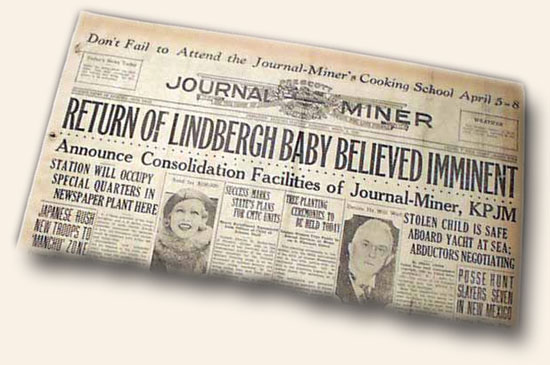What meaningful gift do you give to a 90-year-old?
May 31, 2013 by GuyHeilenman · 1 Comment
One of the greatest challenges when it comes to gift-giving is what to purchase for someone in their 50’s-90’s+ that is both unique and meaningful. While we at Rare Newspapers specialize in offering historic newspapers from the 1600’s, 1700’s, and 1800’s, we also offer Birthday Newspapers – issues from 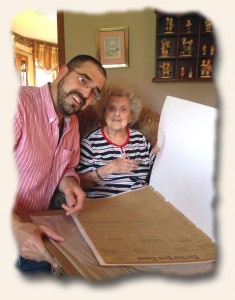 the day someone was born. A recent note from a purchaser of such a gift warmed our hearts. Thanks to R.M. for allowing us to share his response:
the day someone was born. A recent note from a purchaser of such a gift warmed our hearts. Thanks to R.M. for allowing us to share his response:
Original newspapers for the “Day You Were Born” do make wonderful gifts.
The post-Civil War: an era rich in history…
May 27, 2013 by TimHughes · Leave a Comment
 Few eras of American history have been romanticized as the Post-Civil War 19th Century. For those who grew up in the 1950’s & 1960’s, television had more than its fair share of Western-themed shows. And the “Wild West” was a common feature on the silver screen as well.
Few eras of American history have been romanticized as the Post-Civil War 19th Century. For those who grew up in the 1950’s & 1960’s, television had more than its fair share of Western-themed shows. And the “Wild West” was a common feature on the silver screen as well.
Not only can one capture a flavor of that time when the American frontier was pushing further West, but actual historical events can be read as captured in newspapers of the day, when the events happened. This is the intrigue of collecting rare and historic newspapers.
From the moment the Civil War ended, the national focus was on the lands west of the Mississippi. It was common to find reports, even in newspapers from the big cities of the East, of skirmishes with Indians on the Great Plains and elsewhere. The Custer Massacre perhaps ranking as the most notable, but reports can be found on the Battle of Wounded Knee, Captain Jack and the Modoc Indian War, reports of Geronimo, Sitting Bull, the Apaches and others. Newspapers are a great resource for those wishing to explore/collect Native American history.
And what about Outlaws & Gunfights? Stage coach robbery reports are not an uncommonly found in newspapers from the 1870’s and 1880’s, and train robberies and bank robberies could be found scattered throughout newspapers of this period as well. It was a time when some of the more famous—and infamous–names of American history could be found in newspapers, including Jesse James and his gang, Billy the Kid, Wyatt Earp (yes, there are newspaper reports of the Gunfight at the O.K. Corral), the Dalton Gang, Younger brothers, Robert Ford, Buffalo Bill, Jim Bridger, Vasquez, Doc Holliday, Kit Carson, Lizzie Borden, and on and on. Although “Jack the Ripper” was a name from London crime history his deeds made headlines on this side of the Atlantic as well. Reports of their deeds are not fictionalized; they are the events as reported in newspaper accounts of the day.
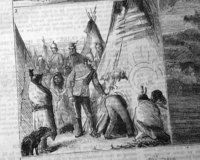 Some the famous towns of the Old West had their own newspapers and can be purchased for anyone’s collection, including titles from Tombstone, Leavenworth, Deadwood, Tucson, Reno, San Francisco, Leadville, Carson City, Denver, Salt Lake City, and many more.
Some the famous towns of the Old West had their own newspapers and can be purchased for anyone’s collection, including titles from Tombstone, Leavenworth, Deadwood, Tucson, Reno, San Francisco, Leadville, Carson City, Denver, Salt Lake City, and many more.
Although crime reports were common, there is so much more in newspapers from this era. Politics certainly found their way into newspapers on a daily basis. Ulysses S. Grant and James Garfield were perhaps the most notable Presidents of the era, and reports on the latter’s assassination are commonly found. Science and innovation were the focus of the famous title “Scientific American” which began in 1845 and still publishes today. Within its pages were many reports on Thomas Edison, Alexander Graham Bell and their inventive work, plus illustrations of the creations of many of the devices and improvements we still enjoy today. Many were first unveiled in Philadelphia’s Centennial Exposition of 1876 and the Columbian Exposition at Chicago in 1893.
It was a time when Brigham Young and the Mormons were venturing west, ultimately to settle in the Salt Lake City Valley. P.T. Barnum was making news with his circus, and Frederick Douglass & Booker T. Washington were coming to national prominence as spokesmen for the newly emancipated slaves. The Chicago Fire & the Johnstown Flood were but two disasters which changed the American landscape and graphic accounts were more brutal in the 19th century then they are today. 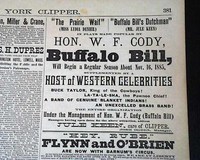 As is the case with present-day newspapers, sporting reports were typically found, with baseball, football, tennis and golf gaining widespread popularity as diversions for not just the wealthy but for everyone.
As is the case with present-day newspapers, sporting reports were typically found, with baseball, football, tennis and golf gaining widespread popularity as diversions for not just the wealthy but for everyone.
As you see the post-Civil War era was very rich in history. And I only touched on a few of the highlights. Newspapers of the era reported not just the events & names we know of through history books, but captured the mundane events of daily existence which provide a fascinating flavor of life in America when the wealth & prestige of the United States was emerging upon the world landscape. A world awaits the collector who delves into this fascinating era of American history.
Just another reason not to smoke…
May 24, 2013 by TimHughes · Leave a Comment
This advertisement for the “Beauty” Bower cigar, found in the Daily Free Press, June 3, 1881, from Bodie, California doesn’t seem to hold true to its name. If this is what the smokers looked like “after”, I’d hate to see the “before”. I wonder if 19th century travelers to the region where confronted with signs stating, “Beware of non-smokers!”.
The Traveler… slave trafficking 100 years ago… Johnson pitching… 24-hour workday… Coney Island – time for some fun…
May 20, 2013 by The Traveler · Leave a Comment
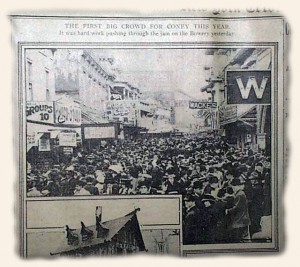 This week I journey to New York City by the way of The New York Tribune of May 19, 1913. There I found a report from John D. Rockefeller on the white slave trafficking that was occurring. “The report says, New York has become the hub of the white slave traffic, not only for the other large cities of the United States, but for Argentine, Brazil, Cuba and Canada also.”
This week I journey to New York City by the way of The New York Tribune of May 19, 1913. There I found a report from John D. Rockefeller on the white slave trafficking that was occurring. “The report says, New York has become the hub of the white slave traffic, not only for the other large cities of the United States, but for Argentine, Brazil, Cuba and Canada also.”
In the sporting news, a headline reads “Walter Johnson Wins His Tenth Straight”. Johnson won 36 games in 1913, 40% of the team’s total wins in the season. In April and May, he pitched 55.2 consecutive scoreless innings, still the American League record and the third-longest streak in history. He also received the MVP this year as well.
Standard Oil Workers were also starting a fight for shorter work days siting “inhuman” conditions, requesting to drop from 24-hour to 8-hour work days.
With the beginning of sunny days, “The new Coney Island, bigger and better” opened to a crowd of 300,000. Here’s to many enjoyable sunny, summer days.
~The Traveler
Collecting 19th Century… Pre-Civil War… Hidden gems abound…
May 17, 2013 by GuyHeilenman · Leave a Comment
An era rich in history… with hidden gems throughout…
Many rare newspaper collectors focus on the more memorable eras of history such as the Revolutionary War, the Civil War, or World War II. Brief date periods –as war events tend to be—can allow for a more concise collection without becoming unduly large if one concentrates on just the major events. Consequently, less notable eras often get over-looked without realizing there is a treasure trove of events which are both fascinating and historically significant found in period newspapers, and well within the range of the average collector.
One such era would be the 1800-1860 period which we designate on our website as the “Pre-Civil War Era”. This was a transitional time in American history as the events of the Revolutionary War and the struggles with creating the federal government gave way to a more secure nation and a more independent America as the nation grew in both size and complexity.
This sixty year era offers a great wealth of events which were formative for the American landscape. The century began with continual coverage of the funeral of George Washington who died less than 3 weeks before the new century began. Thomas Jefferson was the first President to be elected in the 19th century and he did not escape the headaches of war, as the “Barbary Wars” fell within his tenure. He also lead the charge for the Louisiana Purchase which more than doubled the size of the nation and would be home, in full or in part, for 15 new states that would eventually join the Union. Newspaper reports on the Lewis & Clark Expedition were few and far between, but finding even brief mentions in a period newspaper can be quite a thrill.
As the country grew a wealth of notable events transpired & were noted in newspapers of the day. Presidential elections and inauguration are always popular, and there were many in this era: Jefferson, Madison, Monroe, John Quincy Adams, Jackson, Van Buren, William Henry Harrison, Tyler, Polk, Taylor, Fillmore, Pierce, Buchanan, and of course Lincoln, who was elected in this era, but would be inaugurated in the “Civil War Era”, a fascinating chapter of American history onto itself. For those who like to have :complete” collections, finding every election and inauguration is a doable quest.
The War of 1812 falls within this era and provides an opportunity for a sizable and notable collection on its own, from the declaration of War to the many naval battles, the attacks on Baltimore & Washington, the significant battle of New Orleans, and the treaty which ended the war. Collectors like that war events typically allow for collection “bookends” (war declaration and treaty of peace), between which they can become as focused as their budget will allow in collecting the major events.
 The slavery issue would remain a stain on the American fabric during this era, with events such as the Denmark Vesey and Nat Turner insurrections, and the more notable John Brown raid at Harper’s Ferry, as lead-ins to the Civil War. Abolitionist newspapers would be created, including the Liberator & the Emancipator among others, and names such as Frederick Douglass, Dred Scot, and William Lloyd Garrison would make their marks in American history forever. And it was very much a political issue as well with the Missouri Compromise being just one of several federal decisions which had slavery as a basis. Relations with the Native Americans were troubling also, with the Seminole War, the “Trail of Tears”, and the many broken treaties commonly reported in newspapers of the day.
The slavery issue would remain a stain on the American fabric during this era, with events such as the Denmark Vesey and Nat Turner insurrections, and the more notable John Brown raid at Harper’s Ferry, as lead-ins to the Civil War. Abolitionist newspapers would be created, including the Liberator & the Emancipator among others, and names such as Frederick Douglass, Dred Scot, and William Lloyd Garrison would make their marks in American history forever. And it was very much a political issue as well with the Missouri Compromise being just one of several federal decisions which had slavery as a basis. Relations with the Native Americans were troubling also, with the Seminole War, the “Trail of Tears”, and the many broken treaties commonly reported in newspapers of the day.
The Texas Revolution of 1835-1836 has a spice of historical romance similar to the events of the Old West, as both were dramatized in movies. The memorable Battle of the Alamo (starring John Wayne on the big screen) and its fiercely heroic soldiers & citizens, who knowingly faced death to establish the independence of Texas, remains a proud moment in not just Texas but American history. The battles which lead up to that event, and those which followed can be found in newspapers of the day, and mention names we remember from history books including Sam Houston and Davy Crockett.
The Mexican War was another event which resulted in the expansion of the nation with all the major battles reported in newspapers of 1846 to 1848. Just a few years latter attention focused once more on the West with the California Gold Rush and all the romance of a nation heading west to find their fortune. The newspapers reported those thrills, but also reported the struggles & hardships which would befall the many on the trek to the West. Newspapers of the day were more frank than were history books 100 years later.
Westward expansion wasn’t limited to the battle fronts or the quest for gold, as the Missouri River Expedition, The Yellowstone Expedition, the Rocky Mountain exploration, and reports on the Santa Fe Trail were all reported as the adventurous were discovering and creating history—and reported first in newspapers of the day. Such expansion was responsible for states to be created, and reports of statehood for Alabama, Indiana, Michigan, and Illinois among others were detailed in newspapers, as were reports of changes needed in the United States flag to honor such additions.
The Erie Canal, creation of the cotton gin and the Pony Express were notable events during this period. Famous names were commonly found as their reports were making history & reported in newspapers as such, including the likes of Daniel Boone, John Jacob Astor, Bolivar, John Jay, Henry Clay, Horace Greeley, and Kit Carson to name but a few. Of special intrigue is finding reports of famous names before they became famous, such as inconspicuous mentions of Abraham Lincoln from 1848 when he was a member of Congress, or Jefferson Davis from 1833, nearly 30 years before becoming President of the Confederacy.
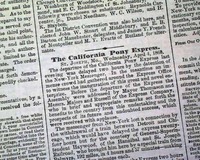 Judaica interest, reports of pirates, the Black Hawk Indian War, runaway slaves, William Henry Harrison’s one month Presidency, and the earliest reports of the Mormons and the journey across the country provide fascinating reading in newspapers of the pre-Civil War era. The Monroe Doctrine is just one of an endless list of historical documents and landmark Supreme Court decisions which were reported in newspapers of the day. Early newspapers from Hawaii, Florida, and Kentucky among others, more commonly found after the 1870’s are a special treat when found before the Civil War. And more than American history found their way into American newspapers. The Battle of Waterloo and the other Napoleonic Wars with mention of Buonaparte, Wellington and other key European figures put world history into perspective when such reports are found alongside notable events in American history.
Judaica interest, reports of pirates, the Black Hawk Indian War, runaway slaves, William Henry Harrison’s one month Presidency, and the earliest reports of the Mormons and the journey across the country provide fascinating reading in newspapers of the pre-Civil War era. The Monroe Doctrine is just one of an endless list of historical documents and landmark Supreme Court decisions which were reported in newspapers of the day. Early newspapers from Hawaii, Florida, and Kentucky among others, more commonly found after the 1870’s are a special treat when found before the Civil War. And more than American history found their way into American newspapers. The Battle of Waterloo and the other Napoleonic Wars with mention of Buonaparte, Wellington and other key European figures put world history into perspective when such reports are found alongside notable events in American history.
If capturing history in the pages of the nation’s newspapers is your hobby, certainly there is much from the 1800 – 1860 period to excite any historical hobbyist. Do not overlook this fascinating era in the growth & development of the United States of America.
The War of 1812… through contemporary newspapers and more…
May 13, 2013 by GuyHeilenman · Leave a Comment
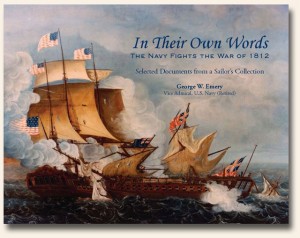 Rare & original newspapers have always been an excellent resource for capturing the context, contemporary response, and details of historic events. This truth was brought home recently via Todd Andrlik’s, “Reporting the Revolutionary War: Before It Was History, It Was News“. Moving slightly into the future, Vice Admiral, U.S. Navy (retired) George W. Emery does the same in his work, “In Their Own Words – The Navy Fights The War Of 1812“. Yet again we are reminded that “History is never more fascinating than when it’s read from the day it was first reported.” Additional details worth exploring may be found at:
Rare & original newspapers have always been an excellent resource for capturing the context, contemporary response, and details of historic events. This truth was brought home recently via Todd Andrlik’s, “Reporting the Revolutionary War: Before It Was History, It Was News“. Moving slightly into the future, Vice Admiral, U.S. Navy (retired) George W. Emery does the same in his work, “In Their Own Words – The Navy Fights The War Of 1812“. Yet again we are reminded that “History is never more fascinating than when it’s read from the day it was first reported.” Additional details worth exploring may be found at:
In Their Own Words: A New Look at the Naval War of 1812
Thanks for this latest contribution which brings the past into the present through the eyes of those who experienced the War of 1812 first-hand.
“Rag paper” allowed newspapers to pass the test of time…
May 10, 2013 by GuyHeilenman · Leave a Comment
One of the biggest surprises–and a pleasant one–novice collectors of newspapers discover is that the oldest newspapers they purchase, those from before 1870, are in much better condition than the more recent “old” newspapers of the late 19th or 20th centuries. How could this be?

Printed on "Rag Paper"
It’s all in the paper. and I literally mean in the paper. Prior to the 1870’s, newsprint was primarily made of cotton & linen fibers. It was handmade and very dependent upon the raw ingredients being available, which was not always the case. It was common to find newspaper advertisements seeking “rags” for the printer, to be used to make the paper upon which the newspaper was printed. Equally as common would be a note from the printer that an issue would have fewer pages or be skipped altogether due to the lack of newsprint. “Rag” paper, as it is called, was not an inexpensive or easily made commodity.
Typically, the older the newspaper, the better the quality. It is not uncommon to find newspapers from the 1680’s which are very white, relatively thick, and extremely pliable. They can be bent, folded, creased, wrinkled and no harm will be done. Do the same to a newspaper of the 1890’s or early 20th century and it will crack and crumble. I recall some years ago a novice customer returning an issue of the London newspaper “The Observator“, 1683, because he claimed “it looked to new to possibly be over 300 years old”. I could not convince him otherwise. Newsprint of 300 years ago simply does not yellow. We occasionally receive similar feedback from similar titles: The Spectator, The Post-Boy, and more. Even a select number of 20th century papers were printed on rag linen as well, typically for use in institutions.
Such handmade paper, particularly that used in the 17th and 18th centuries, can be distinguished from paper made later by holding it up to a light and looking for “chain-lines” which are left from the wires in the paper mold. With this method, fewer fibers accumulate directly on the wire, so the paper is slightly thinner and more transparent to light. This pattern is usually very apparent and appears as lines that run about an inch apart, with several horizontal short lines connecting the long wire lines. Some modern paper has artificially-applied chain lines, and is usually referred to as “laid” paper, which is the name given to handmade chain-line paper.
The handmade chain-line paper made of cotton and linen rags which were soaked in liquid until the fibers broke down into very small bits. Paper was formed by hand by dipping a paper mold into the fiber suspension, and then lifting and shaking off the excess water. The paper sheet was then partially dried before being removed from the mold. Modern handmade paper (used in fine printing of small editions by private presses, as well as in artists books) is basically made by the same process.
The high quality of newsprint was an expensive process & caused newspaper subscriptions to be beyond the means of the average citizen. Consequently holdings of newspapers are relatively small. They were never printed in huge quantities because they cost too much to be widely purchased by the populace. And keep in mind that the percentage of literate people in the 18th and early 19th centuries was not what it is today.
The use of “rag paper” for the publishing of early newspapers is one of the great joys of this hobby. Early newspapers–including issues dating back to the Revolutionary War and beyond–need very little care to maintain their state of preservation. We keep such issues on open shelves where they have been for years to no harm. They can be handled & read from beginning to end without risk of damage or harm. Truly, a collector can hold history in his hands, enhancing the tactile experience this hobby enjoys beyond others where “do not touch” is more the norm.
Another benefit of rag paper is that it allows for easy detection of reprint or facsimile newspapers. A common question crossing our desk is “are you sure it is a genuine newspaper?” or “is my newspaper genuine or not?” When I authenticate newspapers one of the easiest determinants is the quality of paper. If the newsprint is browned or yellowed and fragile to the touch, chances are exceedingly good it is not a pre-1870 newspaper (although there are exceptions). Newspapers from the Revolutionary War should not crack when folded or creased.
The vast majority of reprint or facsimile newspapers on the market were never meant to deceive the collector but rather were anniversary issues, done 50, 100 or 200 years after a significant event, or in celebration of the very first edition of that title. They were often give-aways to subscribers. The “New York Herald” of April 15, 1865 is perhaps the most commonly found reprint newspaper, and most fail the rag paper test; they are much to browned or fragile to have been printed in 1865.
It was the industrial revolution of the latter half of the 19th century which resulted in the technology to create newsprint from wood pulp and chemicals. It was a welcomed innovation for publishers as newsprint become much less expensive to make, but it began the downfall for long-term preservation. But then, newspapers were never intended to last more than a day. Another issue would be on the streets for the consumer the next morning, to the delight of publishers across the country.
The Traveler… marching in Birmingham… Hitler’s end… your next party…
May 6, 2013 by The Traveler · Leave a Comment
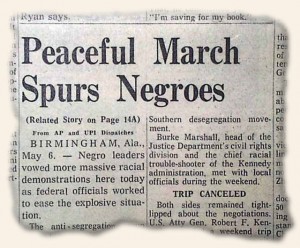 Today I traveled to Detroit, Michigan by the way of The Detroit News for May 6, 1963. There I found that for the past several days Birmingham, Alabama, has been witnessing the “Children’s Crusade”, in which several hundred students had skipped school to march for desegregation and civil rights. Today’s report states it was peaceful with singing, chanting and praying as it was Sunday. Oddly enough the only arrest made (as of this article) was of a white couple inside the church as they were not permitted inside the church.
Today I traveled to Detroit, Michigan by the way of The Detroit News for May 6, 1963. There I found that for the past several days Birmingham, Alabama, has been witnessing the “Children’s Crusade”, in which several hundred students had skipped school to march for desegregation and civil rights. Today’s report states it was peaceful with singing, chanting and praying as it was Sunday. Oddly enough the only arrest made (as of this article) was of a white couple inside the church as they were not permitted inside the church.
Also in the paper was a headline “Found Hitler’s Body in ’45, Reds Say in War ‘Secrets'” which also included a large photo Adolf Hitler and his wife, Eva Braun. This was information being released about the disposition of Hitler’s body from the release of a book by Cornlius Ryan entitled “The Longest Day”.
Did you ever want to be the life of the party? There is a story of a 15-year-old boy that, with a novelty ring, “touted to possess ‘hypnotic’ powers”. Well, within a few minutes, he truly ended up placing a young lady into a trance but was unable to get her totally out of it. A call to her parents, a trip to the hospital, and a psychiatrist later, the trance was broken. Just be careful at your next party with your jewelry and what you say!
~The Traveler
Unfortunately an erroneous report…
May 3, 2013 by GuyHeilenman · Leave a Comment
Premature reports which have proven to be untrue are all too common in newspapers of all eras. The famous “Dewey Defeats Truman“ headline of the “Chicago Tribune” of 1948 is perhaps the most well known. Here is one which I’ve not seen before as reported in the “Prescott Journal Miner” of Arizona, April 3, 1932. It was just over a month later that the Lindbergh baby was found dead. Please share other false reports with the collectible community.